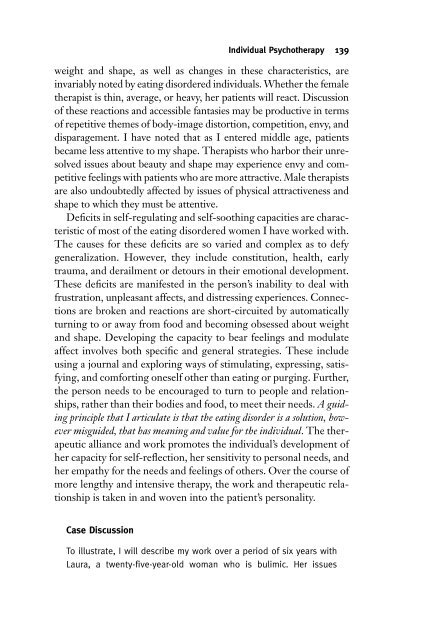Eating Disorders - fieldi
Eating Disorders - fieldi
Eating Disorders - fieldi
Create successful ePaper yourself
Turn your PDF publications into a flip-book with our unique Google optimized e-Paper software.
weight and shape, as well as changes in these characteristics, are<br />
invariably noted by eating disordered individuals. Whether the female<br />
therapist is thin, average, or heavy, her patients will react. Discussion<br />
of these reactions and accessible fantasies may be productive in terms<br />
of repetitive themes of body-image distortion, competition, envy, and<br />
disparagement. I have noted that as I entered middle age, patients<br />
became less attentive to my shape. Therapists who harbor their unresolved<br />
issues about beauty and shape may experience envy and competitive<br />
feelings with patients who are more attractive. Male therapists<br />
are also undoubtedly affected by issues of physical attractiveness and<br />
shape to which they must be attentive.<br />
Deficits in self-regulating and self-soothing capacities are characteristic<br />
of most of the eating disordered women I have worked with.<br />
The causes for these deficits are so varied and complex as to defy<br />
generalization. However, they include constitution, health, early<br />
trauma, and derailment or detours in their emotional development.<br />
These deficits are manifested in the person’s inability to deal with<br />
frustration, unpleasant affects, and distressing experiences. Connections<br />
are broken and reactions are short-circuited by automatically<br />
turning to or away from food and becoming obsessed about weight<br />
and shape. Developing the capacity to bear feelings and modulate<br />
affect involves both specific and general strategies. These include<br />
using a journal and exploring ways of stimulating, expressing, satisfying,<br />
and comforting oneself other than eating or purging. Further,<br />
the person needs to be encouraged to turn to people and relationships,<br />
rather than their bodies and food, to meet their needs. A guiding<br />
principle that I articulate is that the eating disorder is a solution, however<br />
misguided, that has meaning and value for the individual. The therapeutic<br />
alliance and work promotes the individual’s development of<br />
her capacity for self-reflection, her sensitivity to personal needs, and<br />
her empathy for the needs and feelings of others. Over the course of<br />
more lengthy and intensive therapy, the work and therapeutic relationship<br />
is taken in and woven into the patient’s personality.<br />
Case Discussion<br />
Individual Psychotherapy 139<br />
To illustrate, I will describe my work over a period of six years with<br />
Laura, a twenty-five-year-old woman who is bulimic. Her issues









